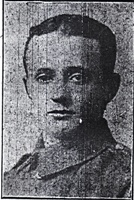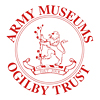
Photograph of Harry from the Ashton Reporter, 10th November 1917. Held in Tameside Local Studies and Archives Centre.

(L to R) British War Medal; Allied Victory Medal
Harry was born in around 1896 in Ashton-under-Lyne, Lancashire. His father was called Edwin and his mother was Sarah Ann. He was their eldest child. His siblings were Ernest, Noel, Edna, Ada and Sarah. Two other children had died by 1911, we don't know their names.
Like many thousands of Ashton residents, Edwin worked in a cotton mill. In 1901 he was a spinner and ten years later he was a minder. His family lived at 21 Newton Street in St Peter's, Ashton, during Harry's childhood. As he grew up Harry attended Gatefield Sunday School in Ashton.
By 1911 Harry had joined his father in the cotton industry. He was a piecer in a cotton mill. We don't know which mill this was, or whether it was the same one as his father. In 1914 he worked at Atlas Mill in Waterloo, Ashton.
The First World War broke out in August 1914 and Harry joined the Army that November. He chose to join the 9th Battalion of the Manchester Regiment. This was a unit of the Territorial Force based in Ashton. It had been sent overseas in September, so once new recruits such as Harry were trained they were assigned to the second 9th Battalion (2/9th). This was based in Southport, Lancashire until November, and then moved to Heyward's Heath in Sussex.
Soldiers serving with units of the Territorial Force were given new service numbers in around March 1917. Harry's was 351333. We don't know his old number. At around the same time the 2/9th Battalion was sent to France.
Harry served in A Company of the 2/9th Battalion during his time in France. He was a popular soldier, and well liked by his comrades. He served around Givenchy and La Bassee until late June, when the battalion moved north to Nieuwpoort, on the North Sea coast in Belgium. They guarded the coast until the autumn.
The Passchendaele Offensive began on the 31st July 1917. It was fought around the nearby town of Ypres. The 2/9th Battalion joined this attack on the 9th October, when they took part in an attack on Poelcapelle.
The battalion attacked over flooded ground that had been turned into a sea of mud by shelling and rain. Their attack began well, and they captured a number of German positions, but the mud slowed them down, and other German soldiers were able to inflict a large number of casualties. By the end of the day the attack was bogged down and could not continue. Harry was one of the men killed. He was 21 years old.
On the 10th November an article about Harry appeared in the Ashton Reporter newspaper. His parents, who now lived at 80 Oldham Road in the town, had received a letter 'written on behalf of his pals of the 2/9th Manchesters, deploring the loss of so worthy a comrade and so promising son'.
At the time of the article both of Harry's brothers were also serving. Ernest was a member of the 1st Battalion of the King's Own Scottish Borderers, who were serving in France, and Noel was in the Royal Navy. We believe they both survived the war.
Harry's body was never found, so he is now one of the 34952 men remembered on the Tyne Cot Memorial, just outside the town known as Ypres during the war, and as Ieper today. Harry is on one of Panels 120 to 124, 162 to 162A or 163A.
Harry's medals were donated to the Museum of the Manchester Regiment in April 2000.




